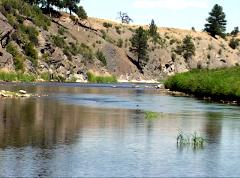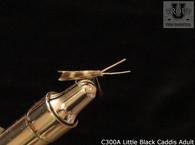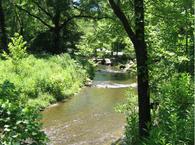
Fly Fishing the Blue Ribbon Smith River in Central Montana is a big challenge but it is worth it. It starts in southern Meagher County and flows northwest between the Little Belt and Big Belt Mountain ranges. It flows past White Sulfur Springs, Montana, and past Smith River State Park as it continues about 63 miles to meet up with the Missouri River. The upper section of the Smith River is rather small and can be waded up or downstream from the Smith River public fishing access which is located about 9 miles above the put in point at Camp Baker. Since much of this section flows through private land it will be necessary to obtain permission to fish from the local farmers and ranchers. Exercise care not to damage or misuse their property in any way.
Fly fishing much of the Smith, however, is only possible by float trips. You can experience multi-day float trips if you are lucky enough to draw a permit in the annual lottery. Reservations can be made by calling 406.454.5861.
The most unique thing about the Smith is that it has only one public put-in (Camp Baker) and one public take-out (Eden Bridge) for the entire 59 miles, which necessitates a four or five day float trip. Floaters must carry their own food, water and camping equipment on the trip. There are eight authorized river outfitters.
The fishing is very good in the 59 mile permit only section of the river. The fish average larger sizes and are predominately browns. This river is a freestone stream subject to the forces of weather. When there is little rain, the flows can become low and the river slows down. Heavy rains cause it to become come high and tricky. The flows are also affected by the irrigation demands of the farmers. If you are experienced enough and lucky enough to get a permit to do a private float trip, be sure to check the water flows before starting. From Eden Bridge down to the confluence with the Missouri River, the trout fishing is not recommended.
Spring:
Mayfly hatches are important starting as early as March with the Blue-winged Olives and they are followed by the Pale Morning Duns that can hatch from about the first of June through the month of August. Brown Drakes can hatch for most June and can be found in the pools and the more moderate sections of the stream.
There are isolated hatches of Little Black Caddis occurring in late April and early May. One of the most prevalent caddisflies is the Spotted Sedges that hatch starting in May and continue all summer.
Summer:
The highly regarded Salmonfly hatch starts around mid-May and continues until mid-June and depending on the weather this hatch can even go into July. About the first of June you will also find hatches of Golden Stoneflies. These hatches can occur through the month of June and are followed by hatches of the Little Yellow Stoneflies which can run through July. Typically, the stoneflies are found in the faster water of the riffles or runs. Short-horned Sedges are plentiful during June and July and the Green Sedges hatch during June and July as well. These caddisflies are mostly habitat the faster moving water so be sure to have some Rock Worms in your fly box. Terrestrials start showing up in large quantities around the first of July and last until the end of September. Imitations of grasshoppers, ants and beetles will be effective.
Fall:
Tricos hatches will occur in the slower parts of the river from about the first of August through September and into the first of October. The bi-brooded Blue Winged Olives will hatch again starting around the middle of September and continue through October. The large October Caddis hatch starts about the middle of September and goes through the middle or end of October. Streamers work best early in the morning and late in the day when the light level is low and also when the water is stained or slightly off color.
Remember, the very best trout flies you can purchase are available at Troutprostore. They have been created to be exact imitations of the actual aquatic insects that trout eat, they are never generic. Give them a try and you will be happy with the results.
The Smith River Fishing Access is most likely the best place to access the stream. It is located roughly 31 miles downstream from the river's beginning or about 9 miles above the Camp Baker Fishing Access which begins the 59 miles permit only section.
Information about the many hatches can be found in the seasonal information contained in the article above. However, remember for the very best imitations of aquatic insects check out the perfect flies at Troutprostore.





